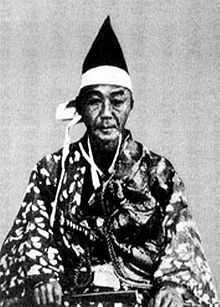Nagai Naoyuki
| Nagai Naoyuki | |
|---|---|
 Nagai Naoyuki | |
| Born |
December 21, 1816 Mikawa Province, Japan |
| Died |
July 1, 1896 (aged 79) Tokyo, Japan |
| Nationality | Japanese |
| Other names | Nagai Genba, Nagai Mondonoshō |
Nagai Naoyuki (永井 尚志, December 21, 1816 – July 1, 1896), also known as Nagai Genba (永井 玄蕃) or Nagai Mondonoshō (永井 主水正), was a Japanese samurai and Tokugawa retainer during the Bakumatsu and Meiji periods.
His great-great-grandchild was Yukio Mishima. Naoyuki's adopted son, Iwanojō Nagai, was the father of Natsu, who was Mishima's grandmother. Iwanojō's real father was Nagasumi Miyoshi (Miyoshi clan) who was a Tokugawa retainer.[1][2][3]
Early life
Nagai Naoyuki, or as he was first known, Matsudaira Iwanojō (松平 岩之丞), was born in the Nukada district of the Okutono Domain by a concubine to Matsudaira Noritada (松平 乗尹). Noritada, while head of a collateral branch of the Tokugawa, was not classified as shinpan, like the Matsudaira of Aizu, but instead as fudai. Iwanojō, Noritada's second son, lost his father at the age of three. Subsequently, he was moved to Edo, to the Okutono domain's main residence, where he was in the care of his adoptive brother, Matsudaira Noriyoshi (松平 乗羨), before being adopted by Tokugawa retainer Nagai Naonori. Following his adoption he took the adult name of Naoyuki (also read "Naomune").[4]
Career
After completing a thorough education in literature, art, and military training, Nagai entered the ranks of the Tokugawa bureaucracy. He served from 1851 to 1852 as an instructor at the Kitenkan, a branch of the Shogunate's Shoheizaka academy, located in the city of Kofu. Shortly after Matthew Perry's arrival, Nagai was placed in charge of casting cannons for coastal defense, and in 1855, he was transferred to the Nagasaki Naval Training Center, where he served as its director. Katsu Kaishu later credited Nagai for much of the training center's progress, as well as the construction of one of its training ships, the Kottoru. In 1857 he went to Edo (modern-day Tokyo) on board the Kanko Maru, Japan's first steam warship, together with 103 of his students.
In 1858, Nagai was appointed one of the first gaikoku bugyō (commissioner for foreign affairs). He served from August 1858 through March 1859; and he served again from November 1865 through April 1867.[4]
Nagai was transferred yet again in 1862, this time to serve as one of the city magistrates of Kyoto. He served as Kyoto machi-bugyō from August 1862 through March 1864. Following this two-year stint in the capital, he was made a shogunate inspector or overseer (ōmetsuke) from March 1864 through May 1865. He was promoted to the position of wakadoshiyori-kaku (aide to the junior counselors) from April 1867 through January 1868; and thereafter, he was one of the wakadoshiyori (junior counselor) from January to March 1868 when the Meiji Restoration signaled the end of the Tokugawa shogunate.[4]
Tenure as Hakodate Magistrate
Returning to Edo following the Battle of Toba-Fushimi, he then joined Enomoto Takeaki and the Tokugawa navy, boarding the Kaiten and heading to Hokkaido by way of Matsushima, in the Sendai domain. In Hokkaido, Nagai was chosen to be one of the city magistrates of Hakodate by the new Ezo Republic. However, the Imperial Army soon began its attack on Hokkaido, and Nagai surrendered at the small fortress of Benten Daiba, along with the survivors of the Shinsengumi.
Later life
After a period of three years in prison, he was pardoned, and again rose to positions of political prominence, serving most notably as the secretary to the Genrō.
One of his descendants, through his adopted son Iwanojō, was the famous author Yukio Mishima.[1][2][3]
See also
- Gaikoku bugyō, commissioners appointed to oversee trade and diplomatic relations with foreign countries
Notes
- ↑ 1.0 1.1 "Persona: A Biography of Yukio Mishima" (Naoki Inose, Hiroaki Sato) (Stone Bridge Pr 2012)
- ↑ 2.0 2.1 ”Final edition-Yukio Mishima complete works No.42-Biographical sketch and Bibliography” (published by Shinchosha, 2005). Japanese title "決定版 三島由紀夫全集・第42巻・年譜・書誌" (Ketteiban Mishima Yukio Zenshu Dai42kan Nenpu・Shoshi) (新潮社、2005年) p.9
- ↑ 3.0 3.1 "Yukio Mishima-The locus of his literature" (Tomoko Etsugu) (published by Kōronsha, 1983). Japanese title "三島由紀夫 文学の軌跡" (Mishima Yukio Bungaku no kiseki) (広論社、1983年) pp.101-107, pp.232-233
- ↑ 4.0 4.1 4.2 Beasley, W.G. (1955). Select Documents on Japanese Foreign Policy, 1853-1868, p. 338.
References
- Beasley, W.G. (1955). Select Documents on Japanese Foreign Policy, 1853-1868. London: Oxford University Press. [reprinted by RoutledgeCurzon, London, 2001. 10-ISBN 0-19-713508-0; 13-ISBN 978-0-19-713508-2 (cloth)]
External links
| ||||||||||||||||||||||||||||||||||||||||||||||